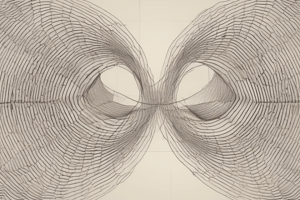Podcast
Questions and Answers
In the Tangent Secant Segment Theorem, what relationship does it describe?
In the Tangent Secant Segment Theorem, what relationship does it describe?
- The tangent length squared equals the product of the secant length and its external segment. (correct)
- The tangent length is always greater than the secant length.
- The tangents from any two points are equal in length.
- The sum of the tangent and secant lengths equals the radius of the circle.
How does the Two Intersecting Chords Theorem calculate the lengths of the segments formed by two intersecting chords?
How does the Two Intersecting Chords Theorem calculate the lengths of the segments formed by two intersecting chords?
- The products of the lengths of each chord segment are equal. (correct)
- The lengths are equal to the radius of the circle.
- The sum of the segments equals the length of the diameter.
- The difference of the segments equals the tangent length.
What does the Secant-Secant Segment Theorem state about the lengths of segments created by two secants intersecting outside of a circle?
What does the Secant-Secant Segment Theorem state about the lengths of segments created by two secants intersecting outside of a circle?
- The sum of the two segments equals the diameter of the circle.
- The square of the longer segment equals the product of the lengths of both segments. (correct)
- The products of the lengths of segments equals the square of the tangent segment.
- The lengths of the segments are equal.
Which theorem would you use to find a relationship involving two secants intersecting at a point outside a circle?
Which theorem would you use to find a relationship involving two secants intersecting at a point outside a circle?
In the context of circle theorems, what do secants and tangents typically represent?
In the context of circle theorems, what do secants and tangents typically represent?
What is the primary difference between secants and tangents in relation to a circle?
What is the primary difference between secants and tangents in relation to a circle?
How does the intersection of two chords affect the lengths of the segments formed within a circle?
How does the intersection of two chords affect the lengths of the segments formed within a circle?
In the context of the Tangent Secant Segment Theorem, how is the tangent segment related to the secant segment?
In the context of the Tangent Secant Segment Theorem, how is the tangent segment related to the secant segment?
What can be inferred about the lengths of segments formed by two secants that intersect outside a circle, according to the Secant-Secant Segment Theorem?
What can be inferred about the lengths of segments formed by two secants that intersect outside a circle, according to the Secant-Secant Segment Theorem?
How do the segment relationships defined by these theorems apply when solving real-world problems involving circles?
How do the segment relationships defined by these theorems apply when solving real-world problems involving circles?
Flashcards are hidden until you start studying
Study Notes
Secant-Secant Segment Theorem
- Describes the relationship between the lengths of segments formed when two secants intersect outside a circle.
- The product of the length of one secant segment and its external segment is equal to the product of the length of the other secant segment and its external segment.
Tangent-Secant Segment Theorem
- Describes the relationship between the length of a tangent segment and a secant segment that intersect outside a circle.
- The square of the length of the tangent segment is equal to the product of the length of the entire secant segment and its external segment.
Two Intersecting Chords Theorem
- Calculates the lengths of the segments formed by two intersecting chords within a circle.
- States that the product of the lengths of the segments of one chord is equal to the product of the lengths of the segments of the other chord.
Relevant Theorem for Intersecting Secants
- The Secant-Secant Segment Theorem is used to find relationships involving two secants intersecting at a point outside a circle.
Secants & Tangents in Circles
- Secants are lines that intersect a circle at two distinct points.
- Tangents are lines that intersect a circle at exactly one point, called the point of tangency.
Tangent Secant Segment Theorem
- Describes the relationship between the lengths of a tangent segment and a secant segment when they intersect outside a circle.
- The square of the tangent segment's length is equal to the product of the lengths of the entire secant segment and its external segment.
Two Intersecting Chords Theorem
- Calculates the lengths of segments created by two intersecting chords within a circle.
- The product of the lengths of the segments of one chord equals the product of the lengths of the segments of the other chord.
Secant-Secant Segment Theorem
- Describes the relationship between the lengths of segments formed by two secants intersecting outside a circle.
- The product of the lengths of one secant segment and its external segment equals the product of the lengths of the other secant segment and its external segment.
Secants and Tangents in Circle Theorems
- Secants are lines that intersect a circle at two points.
- Tangents are lines that intersect a circle at exactly one point, called the point of tangency.
Difference Between Secants and Tangents
- Secants pass through the circle, while tangents touch the circle at a single point.
Intersection of Two Chords
- The lengths of the segments formed by two intersecting chords are related by the Two Intersecting Chords Theorem.
- The product of the lengths of one chord's segments equals the product of the lengths of the other chord's segments.
Tangent Segment and Secant Segment Relationship
- In the Tangent Secant Segment Theorem, the tangent segment is considered a special case of a secant where the two intersection points coincide.
- The relationship between the tangent segment and the secant segment is based on the square of the tangent's length, and the product of the secant's entire length and its external segment.
Secant-Secant Segment Theorem Inference
- According to the Secant-Secant Segment Theorem, the segments created by two intersecting secants outside a circle are related by the product of their lengths and their external segments.
Real-World Applications of Circle Theorems
- Circle theorems like the Tangent Secant Segment Theorem and the Secant-Secant Segment Theorem are used in various real-world scenarios involving circles, such as:
- Engineering: Designing curved structures like bridges, domes, and arches, utilizing the principles of tangents and secants.
- Architecture: Creating arches, vaults, and circular designs in buildings, incorporating the relationships established by circle theorems.
- Construction: Building structures with curved components like tunnels, silos, and reservoirs, using calculations based on circle segments.
- Trigonometry: Solving problems involving angles and lengths in circular systems, utilizing circle theorems to establish relationships.
- Navigation: Calculating distances and angles for navigation and surveying using circle theorems.
Studying That Suits You
Use AI to generate personalized quizzes and flashcards to suit your learning preferences.




